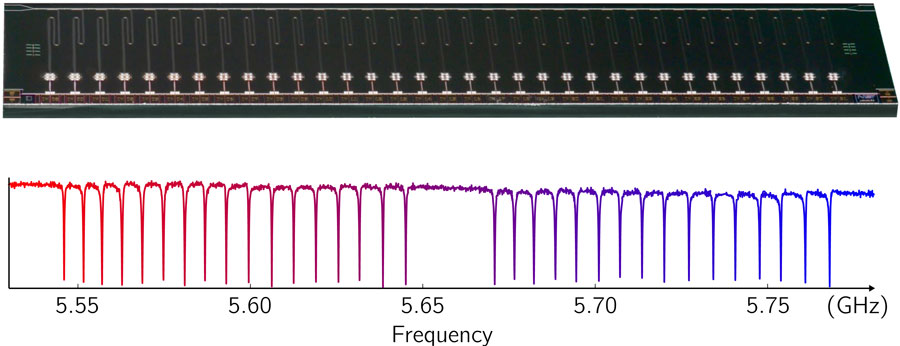A new sensor array using superconducting quantum interference demonstrates impressive sensitivity and bandwidth, offering new applications in nuclear material tracking, astronomy and more.
From the Journal: Applied Physics Letters
WASHINGTON, D.C., August 11, 2017 — Investigators at the University of Colorado, Boulder and the National Institute of Standards and Technology (NIST) have developed a new sensor array-based instrument that offers ultra-low noise detection of small amounts of energy for a number of applications. The new device allows for the collection of data from many more detectors than was previously possible. The advance, reported in this week’s issue of Applied Physics Letters, from AIP Publishing, is expected to allow applications in fields as diverse as nuclear materials accounting, astrophysics and X-ray spectrometry.
The instrument consists of 128 superconducting sensors and combines their output into a single channel provided by a pair of coaxial cables. In the past, array size was limited by the bandwidth available to combine signals into a reasonable number of output channels. This new research demonstrates a hundred-fold bandwidth improvement, and the investigators plan to do even better soon. They overcame the bandwidth barrier by using very cold superconducting microwave circuitry and superconducting quantum interference device amplifiers, known as SQUIDs, capable of boosting the intensity of small signals.
The new device uses radiofrequency SQUIDs to regulate high-quality microwave resonators. When these resonators are coupled to a common microwave feed line, with each resonator tuned to a different frequency, all sensors can be simultaneously monitored.
“It’s as if one were trying to listen to hundreds of radio stations at one time, through one radio receiver,” said Ben Mates of the University of Colorado and lead author of the work. The SQUID resonators boost the signal in each channel, he explained, allowing simultaneous readout of all the radio stations at once.
Versions of the new instrument can detect signals over a wide range of frequencies, from short-wavelength gamma or X-rays to long-wavelength microwaves. Gamma ray detection is crucial for nuclear materials accounting, particularly for tracking plutonium isotopes in spent nuclear fuels. Since plutonium can be used to create nuclear weapons, it is important to have fast, accurate methods to measure the amount of plutonium in nuclear fuel sent for reprocessing.
Current technology for tracking plutonium uses mass spectrometry, but this method is expensive and time consuming. Faster and less costly technologies based on gamma-ray spectroscopy don’t have the accuracy to rule out small discrepancies in amounts of plutonium from a large facility. Only 8-10 kilograms of missing material is needed to build a nuclear bomb. The new array detectors are candidates to improve the accuracy of gamma-ray spectroscopy so that nuclear material can be tracked more easily.

At the other end of the spectrum, the new instrument is expected to improve astronomical studies of cosmic microwave background radiation, which is mostly uniform, although small and important fluctuations exist in its intensity and polarization. The researchers predict that similar versions of their instrument will be used to search for fluctuations in polarization that are a signature of an inflationary epoch in the earliest moments of the universe.
The investigators hope that a larger array will allow them to develop, in collaboration with the Department of Energy’s SLAC facility at Stanford, a unique spectrometer capable of simultaneously collecting and precisely measuring many high energy X-rays from materials under study at the California facility’s X-ray free electron laser. Penetrating X-rays from this powerful tool are increasingly used to understand the properties of matter on ultrashort timescales, but larger detector arrays are desirable even for this bright X-ray source. Toward this end, future work will focus on increasing the array size to a thousand sensors or more.
###
For More Information:
Julia Majors
media@aip.org
301-209-3090
@AIPPhysicsNews
Article Title
Authors
J.A.B. Mates, D.T. Becker, D.A. Bennett, B.J. Dober, J.D. Gard, J.P. Hays-Wehle, J.W. Fowler, G.C. Hilton, C.D. Reintsema, D.R. Schmidt, D.S. Swetz, J.R. Vale and J.N. Ullom
Author Affiliations
University of Colorado, Boulder; National Institute of Standards and Technology (NIST)
